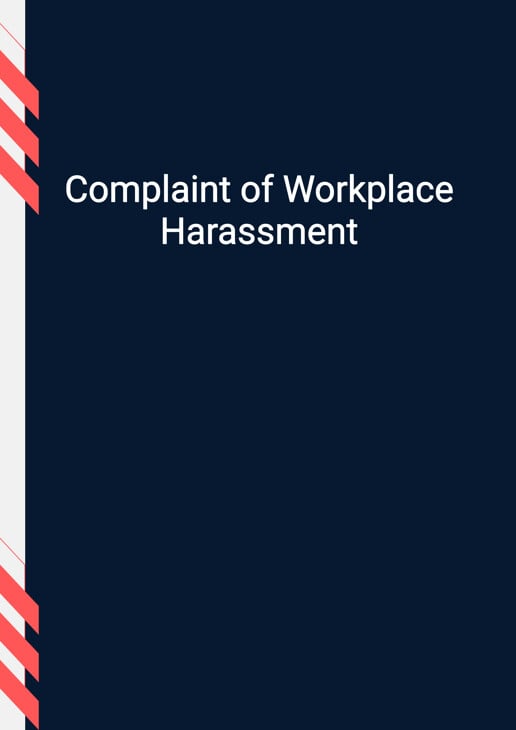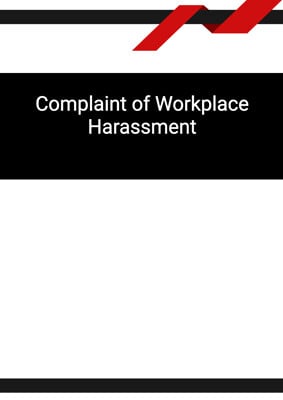How to Tailor the Document for Your Need?
01
Create Document
Click "Create Document" button and the document will be prepared with your account details automatically filled in.
02
Fill Information
Please fill in any additional information by following the step-by-step guide on the left hand side of the preview document and click the "Next" button.
03
Get Document
When you are done, click the "Get Document" button and you can download the document in Word or PDF format.
04
Review Document
Please review the document carefully and make any final modifications to ensure that the details are correct before sending to the addressee.
Document Preview
Document Description
The document titled 'Complaint of Workplace Harassment' is a formal complaint letter written to the department of human resources regarding the harassment experienced by the complainant in the workplace. The importance of this document lies in its ability to bring attention to the issue of workplace harassment and seek appropriate action to address the problem.
The entire document consists of several sections that serve different purposes. The first section includes the account information of the complainant, such as their first name, last name, address, job title, and company details. This information is essential for identifying the complainant and establishing their connection to the workplace.
The second section is the introduction, where the complainant addresses the recipient (the department of human resources) and states the purpose of the letter. In this case, it is to lodge a formal complaint about the harassment they have been experiencing.
The third section provides a detailed account of the harassment incidents, including when they started and how they have been repeated over time. The complainant may include specific details, such as dates, times, locations, and descriptions of the incidents, to provide a comprehensive understanding of the situation.
The fourth section mentions the complainant's attempt to report the harassment to their immediate supervisor but states that the harassment has not stopped. This section may also include any evidence or witnesses the complainant has to support their complaint, such as emails, messages, or testimonies.
The fifth section highlights the impact of the harassment on the complainant's work performance and personal life. It mentions the mental distress, embarrassment, tension, and stress caused by the harassment, both at work and at home.
The final section is the conclusion, where the complainant requests that the recipient take necessary action to stop the harassment immediately and reprimand the harasser. The complainant expresses their willingness to provide further information if needed and signs off the letter with their name.
Each section of the document serves a specific purpose in conveying the details of the harassment complaint and emphasizing its importance in addressing workplace harassment.
How to use this document?
Guidance for using the 'Complaint of Workplace Harassment' document:
1. Gather account information: Fill in the complainant's first name, last name, address, job title, and company details in the respective fields. This information is crucial for identifying the complainant and establishing their connection to the workplace.
2. Introduce the complaint: Address the letter to the department of human resources and state that it is a formal complaint of harassment. Provide a brief overview of the situation, including the duration of the harassment and the position of the harasser.
3. Describe the incidents: Clearly and concisely describe each incident of harassment, including dates, times, locations, and a detailed account of what happened. Be specific and provide enough information to give a comprehensive understanding of the situation.
4. Report previous actions: Mention if the harassment has been reported to a supervisor or any other authority. If so, state the actions taken and whether the harassment has stopped or continued despite the report.
5. Include evidence and witnesses: If available, attach any evidence or provide the names of witnesses who can support the complaint. This may include emails, messages, or testimonies that validate the claims made.
6. Highlight the impact: Explain how the harassment has affected your work performance and personal life. Describe the mental distress, embarrassment, tension, and stress caused by the harassment, both at work and at home.
7. Request action: Clearly state that you expect the recipient to take immediate action to stop the harassment and reprimand the harasser. Express your willingness to provide further information if needed.
8. Sign off: End the letter with a polite closing, such as 'Yours sincerely,' followed by your name. Make sure to include the date of writing.
Remember, this document is a formal complaint, and it is essential to provide accurate and detailed information to ensure proper handling of the harassment issue.
Not the right document?
Don’t worry, we have thousands of documents for you to choose from:











